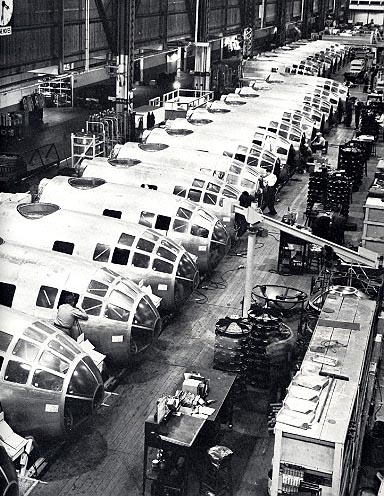|
|
 |
| BUILDING THE "SUPERBOMBER" WOULD NOT BE EASY |
The United States was faced with a dilemma. Building the
much needed superbomber was going to be the most costly and most problem prone project in history. The
new bomber requirements were awesome, involving demands not previously encountered. We needed a plane
with a super long range, capable of carrying a huge payload, pressurized, and with a sophisticated gunnery
system. This would

B-29 ASSEMBLY LINE ctsy BOEING |
require huge engines not then available, a new Radar system, and the ability to fly at
exceptionally high altitudes. The project was given to Boeing, and the Air Force considered it a three
billion dollar gamble. The plane was to be known as the B-29 Superfortress. As work progressed every
conceivable problem that could occur actually happened. The project at times seemed to be moving backwards.
A book could be written disclosing the problems encountered in producing this monster. The main problem
was the massive Cyclone R-3350 power plant, prone to overheating and fires. A succession of delays, malfunctions
and serious accidents very nearly brought an end to the "Superbomber" project. Fortunately,
to the Air Force and to President Roosevelt it was high on the priority list. Months of failures and
disappointments continued. The B-29 was to become a huge engineering headache. Still not determined was
where the B-29s were to be stationed. Was all this effort going to be for nothing? |
| B-29s TO STRIKE JAPAN FROM ASIA |
| General Marshall suggested that we could possibly strike Japanese
industry from China. In 1943 every city on the Asian coast was held by the Japanese, so if we did use
China for B-29 bases all food, fuel, bombs, ammo, and virtually everything used by our forces would have
to be flown in over the Himalayas. This presented an almost impossible supply problem, also the fact
that there were no airfields in China that could support the B-29, or put them in reach of Japan. General
Arnold directed General Wolfe to draw up plans for building airfields in strategic places, and proceed
with project code named "Matterhorn". Chiang Kai-Shek agreed to provide labor to build the
bases, and in July 1943 the first production B-29s rolled off the assembly line in Wichita. Six months
later only 97 planes were delivered, of these only 16 ready to fly. General Marshall became disgusted
with the inefficiency of the production, and by now President Roosevelt was becoming worried. Work on
the airfields in India and China was in chaos, with men and women trying to move earth and rocks in wicker
baskets balanced on their heads. General Arnold became the prime mover to get things moving and put production
on track. General Wolfe was appointed Commander of the XX Bomber Command, a command without any airplanes. |
| B-29s TO ARRIVE IN CHINA |
| General Arnold cabled General Wolfe in India that the first
175 B-29s would depart on March 10, 1944. He went to Salina on the 9th to witness the historic event.
When told that not a single B-29 was ready to go he was enraged, and the ensuing crisis became known
as "The Battle of Kansas". Heads rolled, phones were ringing, streams of trucks and trains
were arriving with parts. The Battle of Kansas was finally being won with the wrath of General Arnold
pushing it. By March 26, the B-29s were on their way for the 11,530 mile trip. The gigantic process of
building airfields and living quarters was slowly progressing. Bases in China were being completed. Four
airfields with 8,500 ft. runways were built in three months by 300,000 Chinese workers. The B-29 turned
out to be it's own worst enemy. The crashes due to malfunction claimed more lives than the Japanese air
defenses. The number one problem now was that everything, bombs, gas, ammo, had to be delivered "over
the hump". Overheating engines continued to plague the bombers. Gen. Arnold kept demanding action
against the Japanese. He ordered Wolfe to launch 70 planes no later than June 15. They were assigned
a prime strategic target, the coke ovens of Japans steel plant, the Imperial Iron and Steel Works at
Yawata in Kyushu. Of 75 planes one crashed on take off, six aborted, and four turned back. Only 47 of
the remaining 64 found the target. Several were hit by flak, three crashed. Seven planes were lost, recon
photos showed some bombs missed the target by as much as 20 miles. Relations between Arnold and Wolfe
deteriorated. Wolfe in an effort to appease Arnold stepped up his flights, with 24 planes dropping incendiaries
and fragmentation bombs on the Nagasaki shipyards. The attacks on Japan increased, with the B-29s, suffering
unacceptable losses due to weather, malfunction, flak, and fighter attacks which now included ramming.
Gen. Arnold, still not satisfied with the unsatisfactory performance, appointed the commander he originally
wanted, Gen. Curtis LeMay. |
|
|
|
|
|
